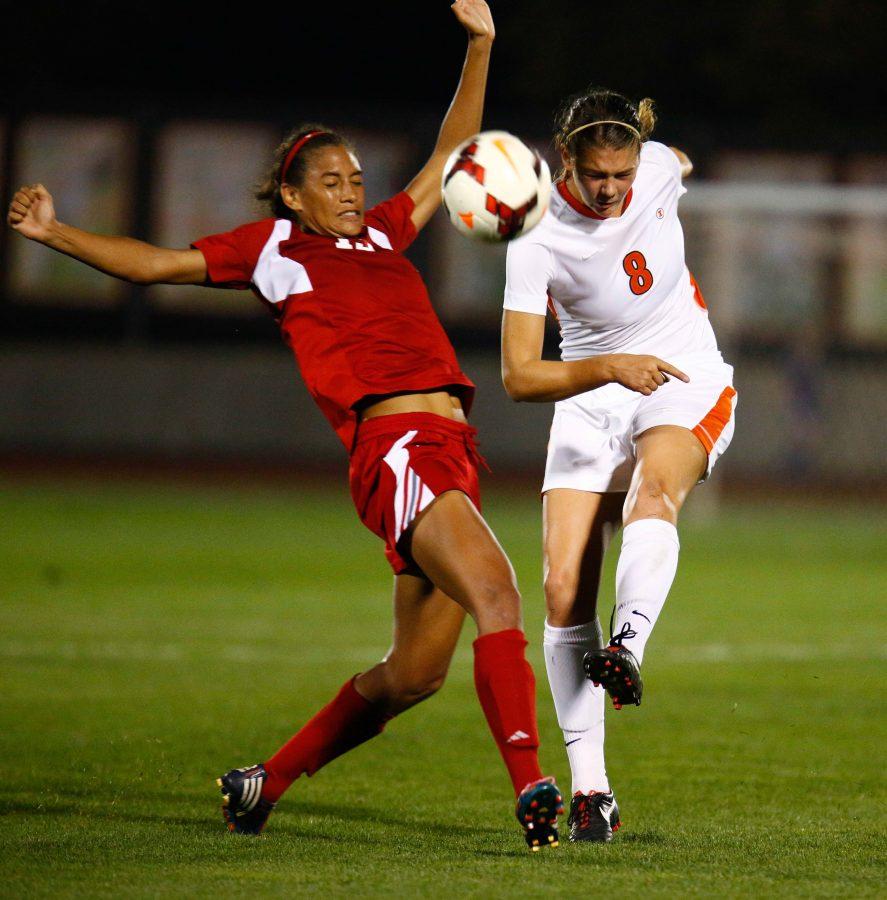Editorial: Concussion epidemic careening out of control
Illinois’ Casey Conine (8) takes a shot during the game against No. 20 Wisconsin at the Illini Soccer and Track Stadium on Saturday, Oct. 12, 2013.
January 26, 2017
Our longform story published in Thursday’s paper looks at one of the most serious and frequently suffered injuries in sports, but one that in the past was often left undiagnosed: the concussion.
The story specifically focuses on these injuries in females, whose concussions from sports such as soccer and softball are often less obvious than their male counterparts on the gridiron or the hardwood.
They aren’t completely ignored, but perhaps just overshadowed by the overwhelming violence of other sports.
Hit after hit, helmet crashing into helmet — the effects of playing football on one’s mind are unavoidable. That much contact will leave an impact, though in varying degrees for each person.
Ten years ago, the word concussion was hardly on anyone’s radar. Since then, so much has changed.
Get The Daily Illini in your inbox!
From high profile football players diagnosed with Chronic Traumatic Encephalopathy (CTE), to the NFL finally admitting a link between football and CTE, to athletes such as former Fighting Illini soccer player Casey Conine suing the University for mishandling her concussion diagnosis, a change is happening.
And given the huge increase in the population of football-playing athletes and athletes in other sports since the generation before us, it’s obvious concussions will only become more widespread as we age.
The time to prepare for the harsh reality of our childhood idols, and ourselves, falling victim to diseases such as CTE is now.
Parents have already begun excluding their kids from contact sports with the highest perceived risk of concussions. Football is the most common example.
But what these parents may not realize, and what our longform story finds, is that concussions have become much more prevalent in “tame” high school sports such as soccer and softball over the past decade.
Sports have always held society in its thralls, from the ancient Greek Olympics to the Super Bowl. But it’s up to us and future generations to determine to what extent the entertainment is worth the consequences.
Despite the known dangers of such activities, we continue to put athletes who give their bodies and sometimes even their lives for their sports on pedestals.
That’s not to say praising those who’ve been hurt doing what they loved is wrong. But given the rapidly shifting public discourse regarding concussions, our society seems to be headed toward a tipping point: the general public could someday value health over glory in sports.
Jeff Miller, the NFL’s executive vice president for health and safety, was asked during a roundtable discussion concussions convened by the U.S. House of Representatives’ Committee on Energy and Commerce if there was a link between football and neurodegenerative diseases.
His answer included the NFL’s acknowledgement of the league’s issues with concussions, but Miller’s follow-up question was more forward-looking.
“Where do we go from here with that information?” Miller added.
And that’s the essential fact: The link between concussions and brain damage is no longer undeniable.
How our generation addresses and fixes that problem is what must be discussed.







